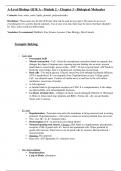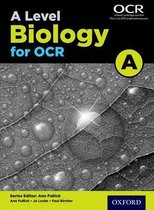A-Level Biology OCR A - Module 2 – Chapter 3 - Biological Molecules
Contents: Ions, water, carbs, lipids, proteins, polynucleotides.
Disclaimer: These notes are for the OCR spec (but can be used for any spec). My notes do not cover
everything but it’s a pretty decent summary. Use at your own risk, there may be errors, but there shouldn’t
be. Also, some words are abbreviated.
Youtubers I recommend: BioRach, Free Science Lessons, Clare Biology, Miss Estruch.
Synoptic linking:
o Ca2+ ions
Presynaptic bulb
Muscle contraction - Ca2+ (from the sarcoplasmic reticulum) binds to troponin, this
changes the shape of tropomyosin, exposing myosin binding site on actin. myosin
head binds to cross bridge. power stroke - ADP + Pi leave myosin head. ATP binds to
break the cross bridge. then it is hydrolysed, resetting the myosin head.
Beta cells - Too much glucose. Glucose enters beta cells through facilitated diffusion.
ATP is metabolised. K+ ion channels close. Depolarisation occurs. Voltage gated
Ca2+ ion channels open. Vesicles of insulin move to and fuse to the cell surface
membrane. exocytosis of insulin.
⇒ Glycogenesis
⇒ Insulin binds to glycoprotein receptors on CSM. It is complementary to the shape.
not lipid soluble. non-steroid/peptide hormone.
Co-factor of blood clots - Collagen in blood vessels damaged. Platelets ⇒ fibrinogen
⇒ fibrin ⇒ forms mesh trap, platelets and RBCs. Forms clot - dry out and harden.
forms scab ⇒ mitosis.
o K+ ions
Repolarisation - Potassium ions enter the membrane to bring neurone back to resting
potential. Hyperpolarisation - extra enter to ensure an action potential does not occur.
3Na+ out. 2K+ in. K+ channels leaky.
Reabsorption of K+ in proximal convoluted tubule?
Stomatal opening and closure. Closure: ABA binds to complementary glycoprotein
receptors CSM of guard cells. K+ moves into epidermal cells. Water potential of
guard cells increase. Water moves out of guard cells by osmosis. Become flaccid =
closed stomata.
Opening: The opposite.
Beta cells: ATP dependant. K+ channels close.
o Na+ ions (sodium)
Depolarisation
Loop of Henle, absorption
, o H+ ions
Chemoreceptors in neck and coronary artery detect acidity of blood.
Chemiosmosis - Electrochemical gradient
In Haemoglobin - Carbonic acid dissociates into H+ + HCO3-.
H+ and Hb ⇒ Haemoglobonic acid to increase pH. (Higher affinity for H+ ions atp
than for O2)
Photosynthesis -
Activation of enzymes. H+ interacts w side chains of AAs, changing 2nd and 3ry
structure. Cld b a post translational modification of enzymes. (Could also be modified
by adding an amine grp or phosphate grp)
Active loading of sucrose. H+ pumped out of companion cells
Cell (shoot) elongation of plants - H+ in cellulose cell wall
Ribosome size in eukaryotes? → 80S
Ribosome size in prokaryotes? → 70S
Role of smooth ER → Make + store lipids/carbs for golgi to process
Role of rough ER → Processes and folds proteins
Role of golgi → Releases molecules in vesicles
Amphipathic → Hydrophobic + hydrophilic regions
Resolution → The ability to distinguish between 2 separate adjacent points
Magnification → How many times larger an image appears compared to its actual size
Different microscopes → Light - low resolution, SE - 3D, shows cell surface, TE - thin, highest
resolution, shows internal structure
Condensation reactions → Form a larger molecule. [Amino acids ⇒ proteins. 2 monosaccharides
⇒ disaccharide. Fatty acids + monoglycerides ⇒ lipids.] WATER RELEASED.
Hydrolysis reactions → Break down into smaller molecule. [Protein ⇒ amino acids. Carbohydrate
⇒ disaccharide + monosaccharide. Lipid ⇒ fatty acid + monoglyceride. WATER IS PRODUCT.
Properties/roles of water → High specific heat capacity (acts as buffer), ice less dense than water +
insulates below to prevent freezing, high latent heat of vaporisation, good solvent, cohesive, surface
tension (allows surface to b habitat), reactant in metabolic reactants.
Carbs
Monosaccharides (make up carbs - C, H, O) → Glucose, fructose, galactose
Physical property of glucose that allows it to be easily transported in the bloodstream →
Soluble / polar
How structure of galactose allows it to be used as a respiratory substrate → Bonds contain
energy so can b broken down by enzymes, soluble so can move, OH grps form H bonds w water so
allows solubility.
Disaccharides → Maltose, sucrose, lactose - joined by glycosidic bonds.





